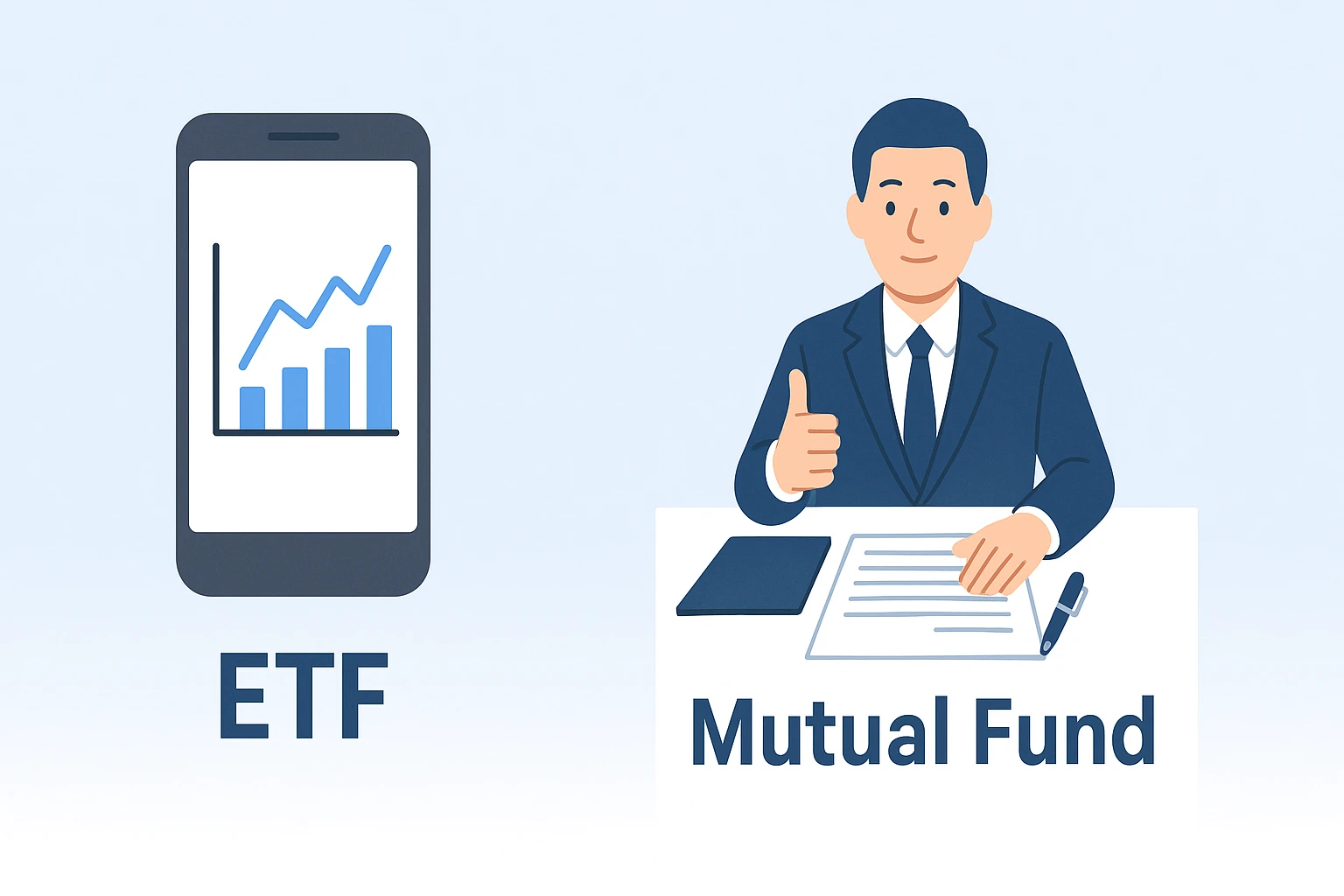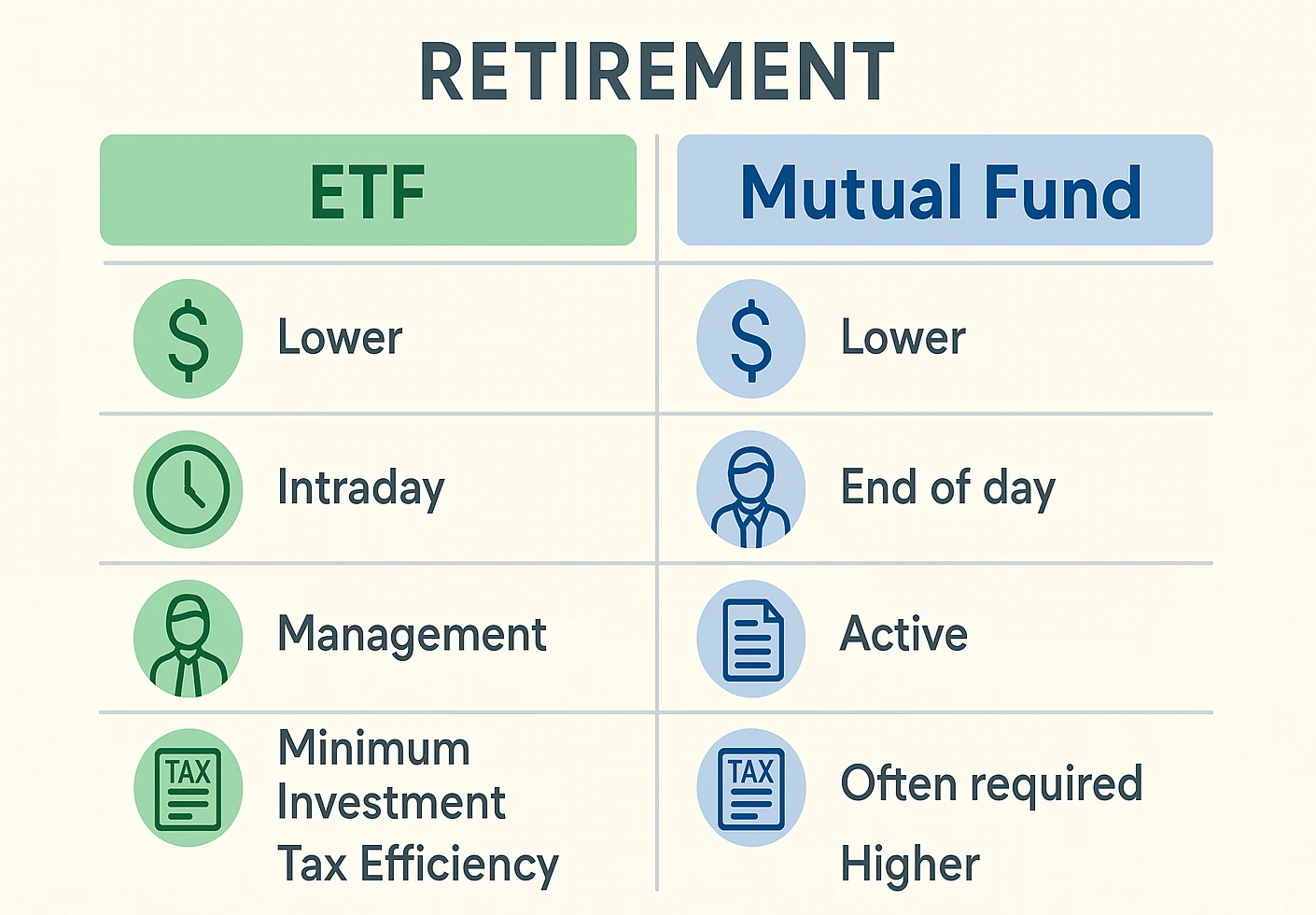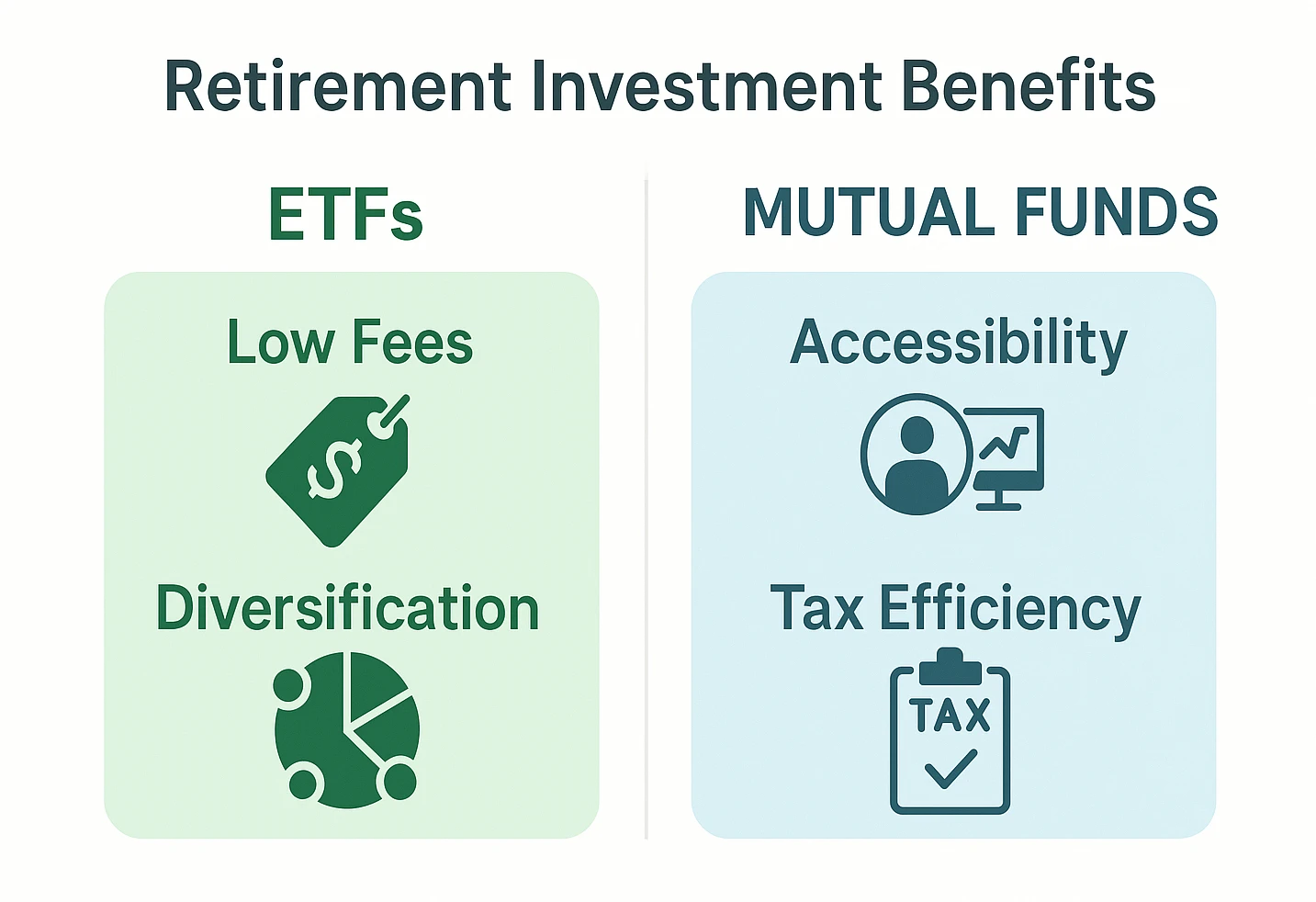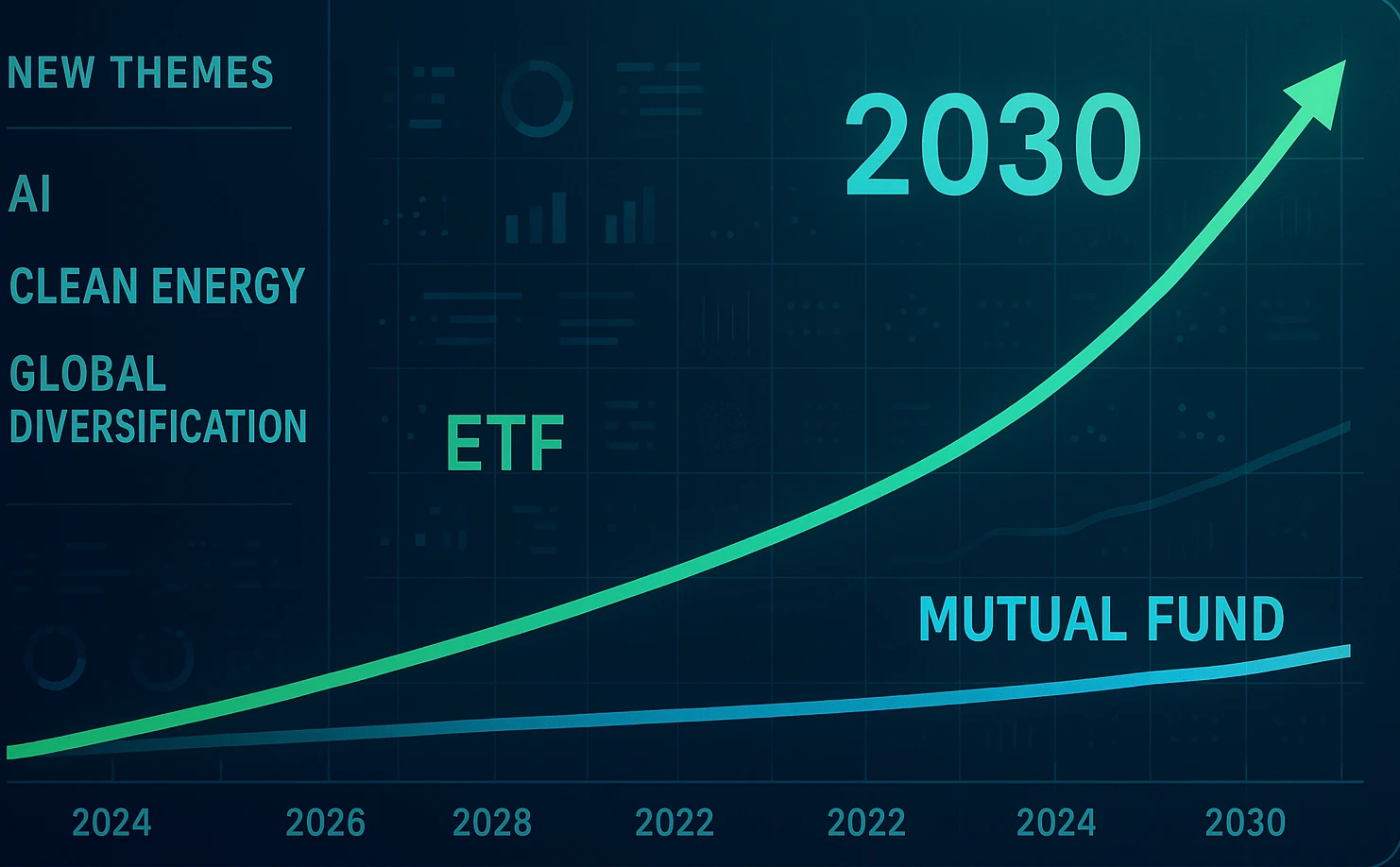
Worried about funding retirement? Choosing between etf vs mutual fund for retirement can shape long-term results. The right fit can lower fees and keep your plan on track. This guide explains how ETFs and mutual funds work, where each shines, and how to match them to your goals—without jargon or hype.
Plan Your Retirement Now!ETF vs Mutual Fund Retirement Planner
Choose your approach (auto-updates)
Compare options and see suggestions instantly.
Table of Contents
What Is ETF vs Mutual Fund for Retirement?
Choosing between ETFs and mutual funds for retirement means weighing how they trade, what they cost, and how they’re taxed. Exchange-traded funds (ETFs) trade throughout the day like stocks and typically seek index-tracking exposure (for example, a total-market ETF). Mutual funds pool investor assets and price once per day at net asset value (NAV); many track indexes while some are actively managed. Both structures can diversify across hundreds or thousands of holdings.
Beyond structure, consider how each fits your saving habits. If you prefer making contributions on a set schedule, most providers make it simple to automate into mutual funds. If you value intraday control and transparent pricing, ETFs can align better with how you like to place trades. Either can be used as a core, as long as costs are kept low and the exposure is broad.

Why It Matters for Retirement Investors
The ETF–mutual fund decision affects costs, flexibility, and taxes. ETFs often come with very low expense ratios and intraday trading, while mutual funds offer end-of-day pricing and may include automatic rebalancing options. For tax considerations, ETFs are generally structured to reduce capital-gains distributions compared with many actively managed mutual funds, though results vary by fund. For a primer on structural differences, see Investopedia’s guide.
Cost Efficiency
Costs compound over time. A seemingly small expense-ratio difference can matter when contributions, employer matches, and reinvested dividends work for decades. Favor low-cost building blocks for your core holdings, then add tilts only if they serve a clear purpose.
Flexibility and Accessibility
ETFs allow intraday execution and transparent pricing; mutual funds simplify logistics with end-of-day trades and optional automation. If you tend to make frequent tweaks, ETFs can be helpful; if you prefer less decision friction, mutual funds reduce touch points.
Behavior and Process
Good results usually come from a repeatable process: automatic contributions, periodic rebalancing, and sticking with a risk level you can live with. Structure (ETF or mutual fund) supports the plan, but your discipline drives the outcome.
Benefits of ETF vs Mutual Fund for Retirement
Each option has strengths. Broad-market ETFs tend to offer very low costs and clear, rules-based exposure. Income-oriented mutual funds can prioritize stability and distribution policies that suit retirees. Both can diversify across many securities and can be used together in a plan.
- Low Fees: Many index ETFs have very low expense ratios, which can improve long-term outcomes.
- Diversification: Both ETFs and mutual funds can track broad indexes or specific segments.
- Accessibility: ETFs trade during market hours; mutual funds support scheduled contributions and rebalancing.
- Tax Awareness: ETFs often distribute fewer capital gains than many active funds; tax results depend on the fund and account type.
Example Core Allocations by Goal
The mixes below are illustrative starting points. Tweak weights to match your risk tolerance and timeline.
| Goal | Equities | Bonds/Cash | Notes |
|---|---|---|---|
| Growth (long horizon) | 80–90% (US total market + international) | 10–20% (US bond index) | Keep costs low; rebalance annually. |
| Balanced | 60–70% (broad stock exposure) | 30–40% (aggregate bonds) | Pairs well with an automatic rebalancing rule. |
| Income-tilted | 40–60% (diversified equity) | 40–60% (bonds, possibly short-intermediate) | Focus on stability and sequence-of-returns risk. |

Pros and Cons to Watch
ETFs require basic order-type knowledge and can invite overtrading during volatility. Mutual funds often have higher expense ratios and may require minimum investments, but can reduce decision friction with end-of-day pricing and optional automatic rebalancing.
Learning Curve
Understanding spreads, market/limit orders, and rebalancing disciplines helps ETF users avoid common mistakes. If you rarely place trades, a simple mutual fund lineup may be easier to maintain.
Cost vs. Management
Active management can justify higher fees in some cases, but low-cost index exposure is difficult to beat over long horizons. If you use active funds, clarify the role they play and compare costs to passive alternatives.
Tax Implications
ETFs tend to be tax-efficient due to creation/redemption mechanics. Actively managed mutual funds may distribute capital gains more frequently. Account type matters: tax-advantaged accounts mute distribution differences; in taxable accounts, manage withdrawals and harvesting with care.

How to Choose ETF vs Mutual Fund for Retirement
Start with goals—growth, income, or balance—and your timeline. Broad-market, low-fee ETFs can be compelling long-term building blocks for growth. Income-oriented mutual funds can support steadier payouts. Consider risk tolerance, automate contributions, and review annually to keep allocation in line with your plan.
Quick Decision Framework
- Prefer set-and-forget? Lean mutual funds with automatic rebalancing.
- Want intraday control? Lean ETFs and define guardrails (e.g., quarterly changes only).
- Minimize costs? Favor low-expense-ratio index exposure for your core.
- Need income? Blend diversified equities with quality bond exposure; match payout needs.
- Reduce behavior risk? Use simple rules (contribution day, annual rebalance, no off-cycle trades).
Common Mistakes to Avoid
- Chasing last year’s winners instead of sticking to a set allocation.
- Over-tilting to narrow themes; keep them as small satellites, if at all.
- Ignoring fees and taxes—small drags compound.
- Skipping rebalancing, which can gradually increase risk.
| Feature | ETF | Mutual Fund |
|---|---|---|
| Expense Ratio | Often very low (index) | Varies; active funds higher |
| Trading | Intraday | End of day (NAV) |
| Management | Typically passive (index) | Index or active |
| Minimum Investment | Share price | Commonly $1,000–$3,000 |
| Tax Efficiency | Often high | Varies; active funds moderate |
Frequently Asked Questions
The Road Ahead for Retiree Portfolios
ETF and mutual fund options continue to expand. Expect more targeted exposures, evolving fee structures, and tools that make building and monitoring a retirement allocation easier. Focus on costs, diversification, and process—then stay consistent.
Whichever structure you prefer, a simple policy statement helps: write your target allocation, rebalancing cadence, and a brief list of “when I will make changes.” Keeping decisions rule-based lowers stress and supports better long-term behavior.
Bottom line
If you value low fees and flexibility, broad-market ETFs often shine. Prefer hands-off simplicity or income targeting? A well-chosen mutual fund can fit the bill. Use the planner above to sanity-check your goal, automate contributions, and review yearly—small cost differences can compound into meaningful gains by retirement.
This content is for informational purposes only and not financial advice. Consult a professional before making financial decisions.

